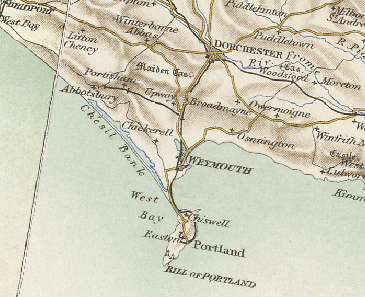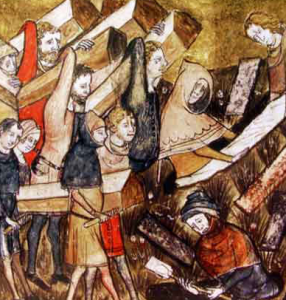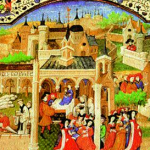Hampshire has the dubious honour of being the probable point of entry for the Black Death into England in the summer of 1348
To understand the spread of the black death through England involves an understanding of merchant shipping movements because not only did these tough versatile little vessels bring wine, wheat and spices to our shores they also brought the plague. The first occurence of the black death in Hampshire began years of misery and fear across the country.
In the latter part of 1348, two ships set out from the French port of Bordeaux for the port of Bristol. As with all such trips, their journey was broken at one of the southern coasts ports. The coast of Hampshire and Dorset was scattered with large and small ports. Ships in the C14th were dependent upon a simple rig and sail system and simple navigation aids to set course for their destination. They would therefore often find themselves pitching up at a little port before making their way to their final destination.
The two ships leaving Bordeaux fetched up in the port of Melcombe Regis. This prosperous little port enjoyed its sheltered position between the large port of Southampton and Dartmouth. The month was June and the crews disembarked after their three week journey but not all was well on board the docked vessel. A fit crew had departed from the French port but several men had fallen ill whilst crossing the channel and when taken off the ship in Melcombe Regis, they were found to have large boils in their armpits and groin. Within days they were dead and many more of the crew were falling ill.
No one in Melcombe Regis spoke of the illness that had sprung up in their midst
The merchants of Melcombe Regis chose to keep quiet about the deaths for fear of halting trade in their prosperous little town but then, its 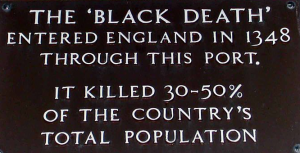 inhabitants started to become ill and the first English victims of the plague died.
inhabitants started to become ill and the first English victims of the plague died.
News of the Continental plague was spreading throughout the country as a whole but people were unaware that it had already reached the shores of England and was spreading ever slowly out of the isolated port in Dorset. The deaths of members of the clergy are recorded and by tracking these reported deaths the spread of the disease can be mapped. It crept along the Cornish coast up to the mouth of the River Avon. It was responsible for the deaths of priests East of Melcombe Regis at Wareham and Wool. Priests were on hand to commune with people and were often called to be present at the bedside of the sick and dying so it seems entirely logical that they would be amongst the first to die.
It has been suggested that Southampton was the port of entry for the disease but the deaths at Melcombe Regis seem to pre-date those at Southampton.
The first recorded deaths in Hampshire
In Hampshire the first recorded deaths were at Titchfield. The haven formed where the River Meon meets the sea was just two miles away and it seems likely that the disease arrived here on board some vessel.
The manorial court of Titchfield of October 1348, records the death of eight tenants from the disease. For a while the disease seemed to be contained at Titchfield. Even the great port at Southampton did not have the plague at this time.
Burying the dead
Bishop Edington of Winchester, wrote to his diocese in Winchester to make all necessary masses and processions ahead of the spread of the disease but inevitably, it made its relentless way through the population of Winchester.
There was a great deal of anger in Winchester over the burial of plague victims in the Cathedral cemetery and when Bishop Edington wanted to extend the cemetery into the Square where the local people held their market and fair, there was a great deal of angst.
Eventually cemeteries had to be prepared on unconsecrated land and people were no longer given the last rites, there simply were not enough priests to do so and of course as they went from one poor diseased soul to another they were spreading the disease also.
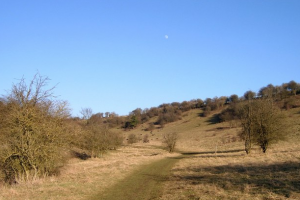
Path next to plague pits St Catherines Hill Winchester © Copyright Maggie Buchanan and licensed for reuse under this Creative Commons Licence
By October 1348 the disease was in Portsmouth, Walter de Corf, the rector of Portsea had died sometime in the early part of 1349. The Domus Dei in Portsmouth received pilgrims and strangers as they passed on their way to one of the famous shrines Canterbury or Winchester, aiding the spread of the disease still further.
By 1349 the Black Death had taken a firm hold of Hampshire and the first half of the year saw the plague at its worst.
The numbers of clergy dying in Winchester was close to 50%, the highest number for any diocese in England.
Figures from the Bishop’s estates show how the tenants were falling victim to the disease at an alarming rate. At Bishops Waltham the death rate was 65%. It struck rich and poor alike but the rate of death amongst the poor was inevitably higher, given the conditions in which they were forced to live.
The impact on the economic wealth of Hampshire was huge. Trade routes and centres ground to a halt, there were not enough people to farm the land and life in wealthy settlements such as Titchfield was changed irrevocably.
In a reference in the roll records for 1350, for the hamlet of Quob, near Titchfield, a statement was made that the tithingmen of Quob were absent because they had all died in the pestilence.
Archaeological evidence of the black death
The palgue was carried by fleas living on the black rat. When a number of dockside sites in Southampton were excavated, there was a notable increase in the number of rats and their predators from the C11th/C12th and the C13th/C14th.
Looking elsewhere in Hampshire, inland from the coast, sites abandoned abruptly due to the plague were found too have evidence of black rat populations and increased numbers of cats and dogs. The University of Southampton holds data showing increased numbers of rats at sites at Faccombe Netherton, Hatch Warren, Foxcotte near Andover and Hamble Priory.
A third of the population died from the disease throughout England, the impact of the black death changed society
What came after the Black Death was large scale social change, the high cost of labour and the low cost of land benefited the peasants and caused problems for the wealthier landowners. More land became available for agriculture, colleges such as Winchester College were founded to educate new priests and social mobility for the peasants became possible. It led to the peasants revolt of 1381, when the very heart of society in England looked as if it would be shaken to its core.
The Black Death was probably the single most important event in British history, the repercussions still felt centuries later as the true fragility of life had become more apparent.
There are several abandoned villages in Hampshire, where the population was completely decimated by the disease such as at Idsworth where the population seems to have melted away, leaving the church standing alone in a field.
There is an excellent video made by students of Southampton University about the plague in Hampshire.
The Black Death in Hampshire by Tom Beaumont James (Winchester, 1999) is an excellent resource

